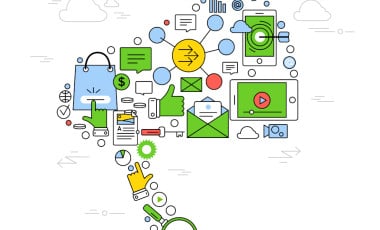Top Email Segmentation Tips and Tricks to Drive More Conversions
Email marketing is still recognized as a high ROI-yielding marketing channel, even in a social media-dominant market. The reason for its popularity and success is the personalized engagement it offers.1
Let's not forget how easy it is to get started with email marketing—all a business needs is a recipient's email address, and they can start sending emails. But that's also where the problem arises. Sending emails is easy, but converting customers or persuading them to take action is where things get complicated.
This is why it's necessary to segment email addresses. Segmenting can help tailor the campaign to the proper recipients. But what exactly is email segmentation? Learn more about email segmentation and helpful tips and tricks to increase conversions in this blog.
What is Segmentation in Email Marketing?

Segmenting is grouping customers/audience/email addresses into smaller segments based on their demographics, location, interests, pain points, etc.
Sending emails without segmenting is not a great practice; the emails won't resonate with all audiences. In the past, unsegmented emails, despite being irrelevant, were often sent to recipients with unsatisfactory results.
To tailor the emails to the relevant customers, marketers had to segment them based on demographics, location, industries, designation, funnel stage, company size, interests, etc.
Segmentation helps businesses send personalized emails to the segmented target audience, thus getting a high engagement rate and saving those emails from being reported as spam.
Why Email Segmentation Matters
Email marketing success depends on the email's open and click-through rates. Nearly 47% of customers state they open emails based on the subject line alone. Further, a 50% increase in open rates when subject lines were personalized. 2
The same goes for click-through rates—if the emails are tailored to and personalized for the recipient, the click-through rates can increase by as much as 139%. But how can businesses personalize and tailor their emails based on the audience? 3
This is where email segmentation comes in. It reveals what the recipients love to receive and helps businesses draft personalized emails that drive conversions.
Steps for Segmenting your data for email marketing
Step 1: Define Your Segmentation Goals
Before you start segmenting your email list, it's essential to determine what you want to achieve with this strategy. Do you want to improve your email deliverability, engagement, conversion rates, or customer retention? Knowing your segmentation goals will help you choose the most relevant and effective segmentation criteria and messages.
Step 2: Identify Your Segmentation Criteria
You must identify the most relevant and actionable segmentation criteria based on your goals. Some standard segmentation parameters include:
- Demographics: age, gender, income, education, occupation, etc.
- Behavioural: past purchases, website activity, email opens, clicks, conversions, etc.
- Psychographic: personality, values, beliefs, lifestyle, interests, etc.
- Geographic: location, language, time zone, climate, etc.
- Firmographic: industry, company size, revenue, hierarchy, etc.
Choose the segmentation criteria that align with your goals, business objectives, and customer preferences.
Step 3: Collect and Clean Your Data
You need accurate and up-to-date data about your subscribers to segment your email list. Ensure you collect and store this information in a centralized and secure database. To gather your subscribers' data, you can use various tools, such as online forms, surveys, sign-up pages, lead magnets, solutions to find email addresses or CRM software.
After collecting your data, clean and validate it to eliminate duplicates, misspellings, inaccuracies, and inactive or invalid email addresses. You can use email verification tools or hire data cleaning services to ensure your segmented lists are high-quality and compliant with email marketing regulations.
Step 4: Create Your Segments
Once you have your data, you can create your segments using email marketing software or spreadsheet tools like Excel or Google Sheets. You can segment your list based on one or multiple criteria and create custom tags or labels for each segment.
Ensure that each segment has sufficient subscribers to make your campaigns worthwhile. However, avoid creating too many segments that might overwhelm your team or confuse your subscribers.
Step 5: Craft Your Targeted Messages
Now that you have your segments, you can create targeted and personalized email messages for each. Use dynamic content, merge tags, personalization tokens, or automation rules to customize your email subject lines, greetings, body copy, images, and calls-to-action based on your segmentation criteria.
Ensure your messages are relevant, helpful, and engaging to your subscribers' preferences and needs. Use A/B testing and analytics to optimize your messaging and improve your segmentation strategy.
Collect Data to Segment Your Email Lists

To segment your email lists effectively, you must collect relevant data about your subscribers. Creating personalized messages and tailoring your campaigns to your audience's preferences and needs will be challenging without enough data.
One way to collect data is by conducting audience research. This involves analyzing your subscribers' demographics, behaviour, interests, and pain points. You can use various methods to derive this data, such as surveys, forms, chatbots, onboarding calls, and customer support chats.
Surveys and forms can help you access customer information, including their pain points and preferences. You can incentivize them to fill out the forms by offering a gift or discount. Chatbots and customer support chats can also provide valuable insights into your subscribers' behaviour, preferences, and pain points.
Collecting and analyzing this data allows you to segment your email lists based on relevant criteria, such as demographics, behaviour, interests, and preferences. This, in turn, will enable you to create personalized and targeted messages that resonate with your subscribers and improve your email marketing performance.
Email Segmentation Parameters
Location
Location-based segmentation allows businesses to personalize their personalized emails more uniquely. In this case, you don't need a form to identify customers' locations; the website cookies will reveal this information automatically, and businesses can target emails specific to the location. 4
For example, November and December are considered holiday seasons in countries like the US, Canada, England, etc. If an email list has customers from these specific locations, businesses can run holiday season offers to get users to purchase a product, upgrade their plan, etc.
Emails can also be personalized using language relevant to the user's location. Businesses can send emails in German to increase conversions if the user is from Germany.
Activities
Segmenting the email list based on the recipient's previous website activity helps businesses tailor their content more effectively. Analyzing customers' behaviour on the website reveals what they're looking for. Emails can then be tailored relevant to their activity and drive conversions.
For example, if a user has just signed up for the service, businesses can send a heartwarming welcome email and a user guide to educate their customers.
The Stage of the Funnel
Multiple stages exist in the marketing funnel, and customers might be in various stages of the funnel depending on their buyer's journey.
Here are the main stages of the marketing funnel:
- Attention
- Interest
- Desire
- Action
Audiences can be segmented into marketing qualified leads (MQLs) and sales qualified leads (SQLs) based on where they are in the funnel. This can help businesses increase conversions by targeting users with relevant emails.
Demographics
Demographic data, such as age, gender, income, education, and job title, can be used to segment an email list. This type of segmentation can help target specific products or services to different demographic groups.
Purchase History
Segmenting an email list based on a user's purchase history can help businesses personalize email content and suggest relevant products. For example, if a user has recently purchased a pair of shoes, an email can be sent with recommendations for matching accessories.
Engagement
Segmenting based on user engagement levels can help businesses identify and re-engage inactive subscribers or reward highly engaged ones. For example, a business may send a special offer to its most engaged subscribers.
Interests
Segmenting based on user interests can help businesses personalize email content and suggest products or services that align with their interests. This can be based on explicit data, such as a user filling out a preference form, or implicit data, such as tracking the content they engage with on the website.
Email Engagement
Segmenting based on email engagement, such as open or click-through rates, can help businesses identify users more likely to engage with future emails and tailor their content accordingly.
Use the Right Email Segmentation Tool
Once the data is there, businesses need a robust email marketing tool to help segment the email list based on various data collected. These tools make it easier for marketers or freelance email marketers to upload data about the customer, and the tool will allow the creation of segments based on different conditions. Certain marketing automation systems, like Hubspot, take it further to include the user interaction data - like whether they signed up for a webinar before etc. to create specific segmented email lists.
The market has specialized email segmentation tools to make your job easier. Tools like Omnisend, Klaviyo, EngageBay, etc., can segment the audience effectively. Before segmenting, ensure you analyze the target audience to create audience personas.
With these tools, there are multiple options to create user segments.
Tips for Email Segmentation
Here are some time-tested tips to make your email segmentation strategy better:
- Use A/B testing: Once you've segmented your email list, conduct A/B testing to determine what works and doesn't. Test variables like subject lines, email copy, CTAs, images, and send times to optimize your email marketing strategy.
- Avoid over-segmentation: While segmenting your email list to personalize your messaging is essential, over-segmentation can lead to smaller groups, making it harder to create compelling emails. Instead, try to balance creating personalized messages and keeping your segmented groups large enough to make an impact.
- Use automation: Consider using automation tools to send targeted emails to specific segments of your list based on their behaviour, interests, or demographics. Automation saves time, ensures consistency, and improves the chances of conversion.
- Please keep it simple: Avoid using complex criteria that may be difficult to implement or lead to errors when creating segments. Stick to simple parameters that are easy to implement, understand and manage.
- Test your segments regularly: Review them regularly to ensure they are up-to-date and effective. Remove inactive subscribers or update their segment based on their recent activity to ensure you reach the right people with the right message.
- Personalize beyond the name: While addressing subscribers by name is common, personalization can go beyond that. Use data collected from your subscribers to personalize your emails by recommending products or services they may be interested in based on their browsing history or past purchases.
- Monitor your metrics: Keep an eye on your email marketing metrics, such as open rates, click-through rates, and conversions, to evaluate the effectiveness of your segmented email campaigns. This will help you adjust your strategy and improve results over time.
Remember that email segmentation is an ongoing process, and it's essential to continually review and update your segments based on new data and metrics.
Conclusion
Email marketing is a cost-effective way to increase customer engagement, unlike paid ads on social media platforms or other similar mediums. However, businesses must use segmented email lists to make these engagements fruitful.
To easily segment customers, businesses must use a robust email segmentation tool to group their customers based on various conditions. Segmenting email lists will make it easy for marketers to target users with the correct emails.
So, have you segmented your email list before? Were the tips and tricks listed in this blog helpful to you? Want to see improved results from your email marketing campaigns? Work with our expert marketing team to learn more about effective email segmentation and how it can boost customer engagement and conversions. Contact us to learn more about our marketing technology related services.



